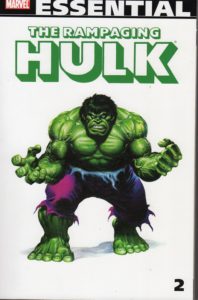Comic Book Review: Essential Rampaging Hulk, Vol. 2 edited by John Denning
Quick recap: In the 1970s, Marvel Comics started doing larger magazines for newsstand distribution, most of them in black and white. One of these was The Rampaging Hulk, which originally featured adventures taking place between the Hulk’s appearances in the first year of his existence. But then it was renamed just The Hulk and retooled to more strongly resemble the then-hot television series starring Bill Bixby and Lou Ferrigno, as well as now being published in color.
This volume continues the run with issues #16-27, which were published 1979-81. It’s a curious mix of the television series and the comics continuity. The usual supporting cast is not seen or mentioned outside of a brief flashback to the Hulk’s origin, and a mention of Doctor Strange in the narration. Nor are there any of the usual supervillains–the closest we get is Rypel, who is more of a Bond villain type that wants to trigger World War Three so his underwater utopia can inherit the Earth. Most of the time, it’s just Robert Bruce Banner wandering from town to town and getting involved with relatively ordinary people’s problems. Interspersed with the Hulk smashing things, of course.
The opening story, “Masks”, has Dr. Banner lured from New Orleans (the night after Mardi Gras, just to be different) to the Florida Keys to participate in a wealthy eccentric’s treasure hunt. Of course, the eccentric has ulterior motives, The final story in the volume, “One for My Baby…and One More for the Hulk!” takes place in Las Vegas, as a past-his-prime crooner tries to get out from under the mob with the help of his new green bodyguard.
This is a real nostalgia blast for me, not just because I read many of these stories when they first came out, but because the writers couldn’t use their usual costumed weirdos to move plots, and thus tended towards topical stories. Three Mile Island, snail darters, the last days of the Cold War, Native American struggles, Hare Krishnas…takes me back.
Of course, not all of these stories have aged well. “A Very Personal Hell” by Jim Shooter has the notorious gay panic scene where Bruce Banner is threatened with rape by a lisping stereotype at the “Y.” (He saves himself by informing the would-be rapist that he is, in fact, Bruce Banner, y’know, the Hulk, you wouldn’t like him when he’s mad?)
And sadly, the ambitious color usage in some of the stories is completely ruined in black & white reprint–it looks muddy, and some of the captions are borderline unreadable. Artists like Gene Colan, on the other hand, make it work.
A couple of the stories deal with attempts to cure Banner of turning into the Hulk, or at least lessen the rift between them. The most striking of these is “Master Mind” in which the Hulk persona winds up in Bruce Banner’s body and goes on a rampage–which could be deadly to the much more fragile scientist.
A couple more stand-out stories: “Heaven Is a Very Small Place” with great art by Herb Trimpe and John Severin is a sad tale of the Hulk finding a peaceful place at last, only to have the illusion fade. “Dreams of Iron…Dreams of Steel” has Bruce Banner getting a job at a care facility for children with developmental disablilities (back then the word “retarded” was acceptable, but the shortened form is also hurled as an insult) and the Hulk bonds with an adult graduate of the facility that works at a steel mill.
Recommended with reservations for fans of the 1970s Hulk show and Hulk fans in general–check your library unless you’re a completist who has to own every Hulk story.

